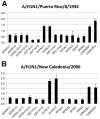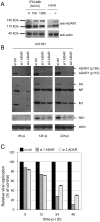The interactomes of influenza virus NS1 and NS2 proteins identify new host factors and provide insights for ADAR1 playing a supportive role in virus replication
- PMID: 23853584
- PMCID: PMC3701712
- DOI: 10.1371/journal.ppat.1003440
The interactomes of influenza virus NS1 and NS2 proteins identify new host factors and provide insights for ADAR1 playing a supportive role in virus replication
Abstract
Influenza A NS1 and NS2 proteins are encoded by the RNA segment 8 of the viral genome. NS1 is a multifunctional protein and a virulence factor while NS2 is involved in nuclear export of viral ribonucleoprotein complexes. A yeast two-hybrid screening strategy was used to identify host factors supporting NS1 and NS2 functions. More than 560 interactions between 79 cellular proteins and NS1 and NS2 proteins from 9 different influenza virus strains have been identified. These interacting proteins are potentially involved in each step of the infectious process and their contribution to viral replication was tested by RNA interference. Validation of the relevance of these host cell proteins for the viral replication cycle revealed that 7 of the 79 NS1 and/or NS2-interacting proteins positively or negatively controlled virus replication. One of the main factors targeted by NS1 of all virus strains was double-stranded RNA binding domain protein family. In particular, adenosine deaminase acting on RNA 1 (ADAR1) appeared as a pro-viral host factor whose expression is necessary for optimal viral protein synthesis and replication. Surprisingly, ADAR1 also appeared as a pro-viral host factor for dengue virus replication and directly interacted with the viral NS3 protein. ADAR1 editing activity was enhanced by both viruses through dengue virus NS3 and influenza virus NS1 proteins, suggesting a similar virus-host co-evolution.
Conflict of interest statement
The authors have declared that no competing interests exist.
Figures







References
-
- Chen W, Calvo PA, Malide D, Gibbs J, Schubert U, et al. (2001) A novel influenza A virus mitochondrial protein that induces cell death. Nat Med 7: 1306–1312. - PubMed
-
- Tan SL, Katze MG (1998) Biochemical and genetic evidence for complex formation between the influenza A virus NS1 protein and the interferon-induced PKR protein kinase. J Interferon Cytokine Res 18: 757–766. - PubMed
Publication types
MeSH terms
Substances
LinkOut - more resources
Full Text Sources
Other Literature Sources
Molecular Biology Databases
Research Materials

